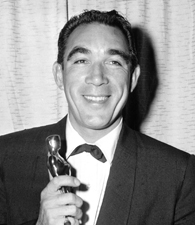Best remembered for his roles in “Zorba the Greek,” “Viva Zapata!” and “La Strada,” prolific actor Anthony Quinn was an icon of old Hollywood masculinity—on the screen, on stage and in real life. Quinn also gained fame as a sculptor and a painter, and later in life became notorious for his numerous romantic adventures.
Anthony Quinn’s Early Days
Anthony Rudolph Oaxaca Quinn was born on April 21, 1915, in Chihuahua, Mexico. He was of mixed ancestry; his mother, Manuela, was half-Indian and half-Mexican, while his father, Francisco, was half-Irish and half-Mexican. His parents had fought with Pancho Villa during the Mexican Revolution.
As an infant, Anthony was taken by his mother across the border to El Paso, Texas, where his father eventually joined them. The family later moved to California and worked as migrant farmers until Francisco found a job as a grip and camera operator in Hollywood. Unfortunately, he died in a car accident when Anthony was only 11 years old.
Following the death of his father, Anthony left school and started working, trying different jobs including boxing, street preaching, the priesthood and architecture. He began taking acting lessons in the late 1920s, and obtained his first non-speaking movie role in 1936, as a convict in the movie “Parole.” A speaking part as a Cheyenne warrior in the film “Plainsman” came later that year.
Sources in this Story
- The Anthony Quinn Trust: About Anthony Quinn
- The New York Times: Anthony Quinn Dies at 86; Played Earthy Tough Guys
- Hollywood.com: Oscar winner Anthony Quinn dies at 86
- ArtsEditor: Unquelled Persona: Encountering the artwork of Anthony Quinn
Quinn’s Notable Accomplishments
Quinn appeared in dozens of films in the late ‘30s and ‘40s, usually as an outlaw or rugged bad guy. He was tall, dark and powerfully built, and “Hollywood seemed to consider his looks ideal to represent almost every ethnicity,” says The New York Times; he portrayed Mexicans, Indians, Italians, Arabs, Asians and various other ethnicities in his early career.
In 1947, he began performing on Broadway and secured the role of Stanley Kowalski in “A Streetcar Named Desire.” His performance on the stage jump-started his film career, and he would produce his finest and most renowned film work during the ‘50s and ‘60s.
He won two Academy Awards, first for his interpretation of Mexican revolutionary Emiliano Zapata in “Viva Zapata!” (1952), and then for his portrayal of painter Paul Gauguin in “Lust for Life” (1956). He was also nominated for Best Actor for his appearances in “Wild Is the Wind” (1957) and “Zorba the Greek” (1964), likely the most memorable role of his career.
He appeared in a variety of exotic and historical roles, playing an Eskimo in “The Savage Innocents” (1960), a Russian pope in “The Shoes of the Fisherman” (1968), the Sheik Auda abu Tayi in “Lawrence of Arabia” (1962), and Chief Crazy Horse in “They Died With Their Boots On” (1941).
The Man and His Work
- “Zorba the Greek” directed by Mihalis Kakogiannis
- “Viva Zapata!” directed by Elia Kazan
- “One Man Tango” by Anthony Quinn, Daniel Paisner
- “Anthony Quinn’s Eye: A Lifetime of Creating and Collecting Art” by Donald Kuspit, Jay Parini, Tom Roberts
The Rest of the Story
Parallel to his career in theater and film, Quinn also worked as a painter, sculptor and jewelry designer. His work was exhibited in the United States and abroad, and continues to sell at galleries and auctions today.
On June 2, 2001, Quinn died from respiratory failure. He was 86 years old, had fathered 13 children and starred in more than 150 movies. To the end of his life, he personified the legend of the Hollywood macho man and the outlaw.
This article was originally written by Anita Gutierrez-Folch; it was updated March 24, 2017.











